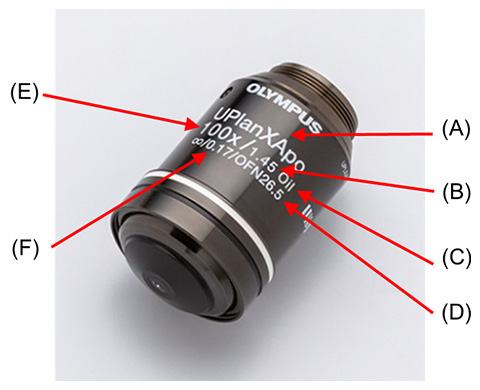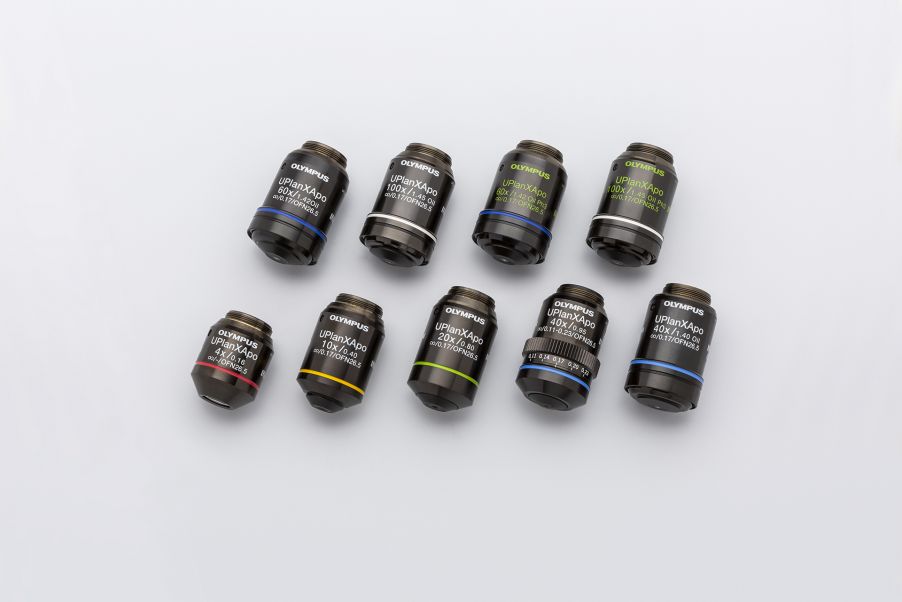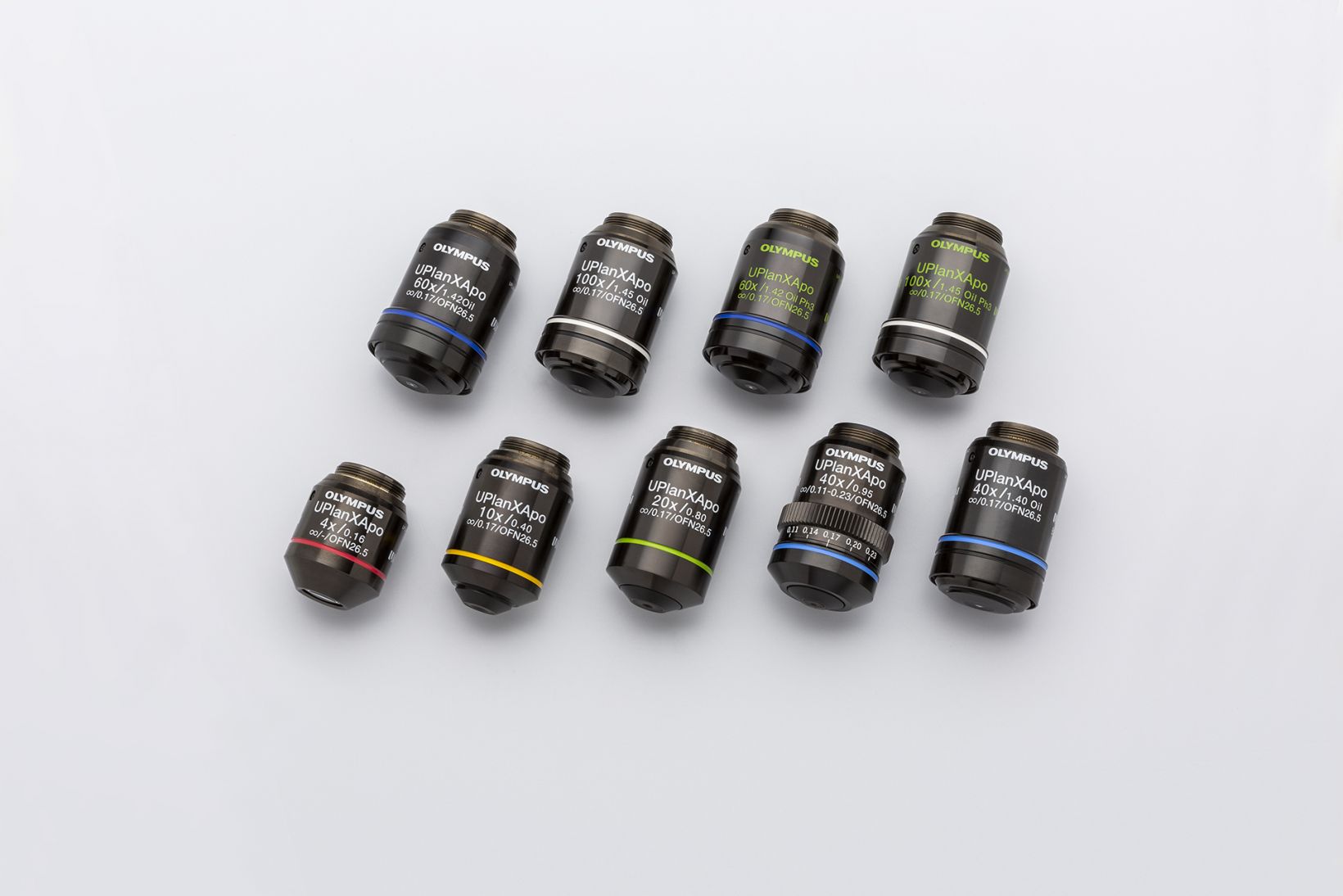Objective lenses are crucial to a microscope’s performance as they affect the quality of the formed image. Evident offers more than 200 types of objective lenses to suit a wide range of imaging requirements in life science and industry. With so many options available, you might be wondering which objective is best for your work.
This is where microscope objective specifications come in. These specifications tell you the optical performance, such as magnification, aberration correction, and other parameters. You don’t have to look far to find them—in fact, our specifications are listed as a code within the objective lens name! This makes it easy to distinguish between objective types at a glance.
In this post, we’ll share how to read the optical performance from the name of a microscope objective so that you can easily find the correct objective lens for your application. As our objective lenses for life science and industrial applications have different naming rules, we’ll discuss how to read the specifications for each field.
Microscope Objective Specifications for Life Science Applications
For life science, we’ll use the objective lens called UPLXAPO100XOPH as an example. You can understand the optical performance from the objective lens name by dividing the name into six parts, 1 through 6. Below is an overview, and we’ll explain each part in the following six sections.

| No. | Categories | Specifications |
|---|---|---|
| 1 | Observation Conditions |
U: Universal
L: Long working distance |
| 2 | Image Flatness | PL (or Plan) |
| 3 | Correction Level of Chromatic Aberration |
ACH
FL APO SAPO XAPO |
| 4 | Magnification | 1.25–150X |
| 5 | Immersion Medium |
No code
O: Oil W: Water |
| 6 | Observation Method |
No code: Brightfield
PH: Phase contrast |
1. Observation Conditions
U = universal objective lens. This objective lens achieves a high level of basic performance in terms of both differential interference performance and fluorescence performance capable of U excitation. It can be used for brightfield observation and fluorescence observation by blue/green (B/G) excitation, as well as for differential interference contrast (DIC) observation and fluorescence observation by U excitation.
DIC observation* is possible due to features such as the pupil position that matches the microscope system from Evident. In addition, it has good transmittance at 365 nm (the U excitation wavelength) and has low autofluorescence, enabling fluorescence observation by U excitation.
*We have some exceptions regarding the availability of universal lenses for DIC observation.
L = long working distance objective lens. This is an objective lens with a long working distance (the distance from the tip of the objective lens to the specimen surface when focused). In general, there is a trade-off between resolution and working distance. If you want space between the objective lens and the sample, or if you want to observe deep parts, give priority to working distance over resolution.
2. Image Flatness
Objectives with PL or Plan are corrected for field curvature at the periphery of the field. This objective type is particularly suitable for imaging because it can focus not only on the center of the field of view but also on the periphery. This enables you to obtain a flat image from the center to the edge.
3. Correction Level of Chromatic Aberration
The correction range for chromatic aberration in objectives differs for each code. The level of chromatic aberration improves in the order of ACH, FL, APO, SAPO, and XAPO. If chromatic aberration is well corrected, sharp fluorescence images with no out-of-focus areas can be obtained for each color even in multicolor observation using fluorescent reagents covering a wide band.
ACH = achromat. Excellent correction of chromatic aberration in two colors (blue and red).
FL = semi-apochromat. Excellent correction of chromatic aberration in three colors (blue, green, and red).
APO = apochromat. Corrects the chromatic aberration of three colors (blue, green, and red) better than FL.
SAPO = super apochromat. Good correction of chromatic aberration in the visible to infrared range (435 to 1000 nm).
XAPO = extended apochromat. Good correction of chromatic aberration in the visible to infrared range (400–1000 nm).
Note that SAPO and XAPO are Evident's original names that indicate the grade of chromatic aberration. Detailed definitions of ACH, FL, and APO are described in ISO, so please refer to ISO19012-2.
4. Magnification
The number before the X represents the magnification of the objective when combined with a tube lens from Evident with a focal length of 180 mm. Evident offers objectives with magnifications ranging from 1.25–150X.
5. Immersion Medium
This code indicates whether it is a dry objective lens used for observation without immersion liquid or an immersion objective lens for observation using immersion liquid. In the case of immersion objectives, the liquid used is represented by the symbol O for oil or W for water.
No code = air/dry
O = oil
W = water
6. Observation Method
This code indicates what kind of observation method* can be used with the objective lens.
No code = brightfield
PH = phase contrast
*The objective may work with other observation methods not expressed in the code, including brightfield (reflected), brightfield (transmitted), darkfield (reflected), darkfield (transmitted), DIC (reflected), DIC (transmitted), phase contrast, relief contrast, polarization, fluorescence (B/G excitation), UV fluorescence (at 365 nm), multiphoton, total internal reflection fluorescence microscopy (TIRF), and infrared (IR). Please refer to our
website for the full objective specifications.
Microscope Objective Specifications for Industrial Applications
We will use the MPLFLN100XBD objective lens as an example in the industrial field. Note that some of the specifications are the same as those of objective lenses for life science. For industrial objectives, you can understand the objective lens name at a glance by dividing it into five parts, 1 through 5.

| No. | Categories | Specifications |
|---|---|---|
| 1 | Observation Conditions |
M: Metal (no cover)
LM: Long working distance for metal SLM: Super Long working distance for metal MX: High NA and long working distance for metal |
| 2 | Image Flatness | PL (or Plan) |
| 3 | Correction Level of Chromatic Aberration |
ACH
FL APO |
| 4 | Magnification | 1.25–150X |
| 5 | Observation Method |
No code: Brightfield
|
1. Observation Conditions
The code M stands for metal, and it is an objective lens for observation without a cover glass. In addition, the following codes are used according to the length of the working distance and optical performance.
M = metal (no cover)
LM = long working distance for metal
SLM = Super long working distance for metal
MX = high NA and long working distance for metal
2. Image Flatness
Like the life science objectives, industrial objectives marked PL or Plan are corrected for field curvature at the periphery of the field of view. This objective type is particularly suitable for imaging because it can focus not only on the center of the field of view but also on the periphery. This enables you to obtain a flat image from the center to the edge.
3. Correction Level of Chromatic Aberration
The correction range for chromatic aberration differs for each code. There are three types, ACH, FL, and APO, and the chromatic aberration performance is defined in the same way as the objective lenses for life science.
ACH = achromat. Excellent correction of chromatic aberration in two colors (blue and red).
FL = semi-apochromat. Excellent correction of chromatic aberration in three colors (blue, green, and red).
APO = apochromat. Corrects the chromatic aberration of three colors (blue, green, and red) better than FL.
Detailed definitions of ACH, FL, and APO are described in ISO, so please refer to ISO19012-2.
4. Magnification
Just like the life science objectives, the number before the X in industrial objectives represents the magnification of the objective when combined with a tube lens from Evident with a focal length of 180 mm. Evident offers objectives with magnifications ranging from 1.25–150X.
5. Observation Method
This code indicates what kind of observation method* can be used.
No code: Brightfield
BD: Darkfield
IR: Infrared
*The objective may work with other observation methods not expressed in the code, including brightfield (reflected), brightfield (transmitted), darkfield (reflected), darkfield (transmitted), DIC (reflected), DIC (transmitted), phase contrast, relief contrast, polarization, fluorescence (B/G excitation), UV fluorescence (at 365 nm), multiphoton, total internal reflection fluorescence microscopy (TIRF), and infrared (IR). Please refer to our website for the full objective
specifications.
Specifications Inscribed on a Microscope Objective Lens
In addition to the name of the objective lens, information on the numerical aperture (NA), magnification, cover glass thickness, immersion liquid, and objective field number (OFN) is provided on the exterior of the objective lens. Below is an example of the UPLXAPO100XO objective that explains how to read these specifications.

| A | Objective lens name |
| B | Numerical aperture(NA) |
| C | Immersion medium |
| D | Objective field number(OFN) |
| E | Magnification |
| F | Cover glass thickness |
Find More Information on Microscope Objective Specifications
Our website provides a wide range of technical content and product information about our microscope objective lenses. For more details, simply refer to the following links:
- Objective Finder: Use the Objective Finder to find information about the NA and back focal plane (BFP) position that cannot be read from the objective lens name alone. You can find helpful tips on using this online tool in our blog post, How to Use the Objective Finder in 5 Easy Steps.
- OEM Microscope Components for Integration: Evident offers a wide variety of microscope units, components, and parts for integration into optical devices used for research, inspection, and production. Explore our OEM microscope component resources to learn more.
We hope this list of microscope objective specifications was helpful! Be sure to bookmark it for easy reference when selecting an objective lens. If you are unsure about choosing an objective lens or have any questions, feel free to contact us. We can help you select the best objective based on factors such as sample type, imaging technique, numerical aperture, and desired magnification.
Related Content
How to Use the Olympus Objective Finder in 5 Easy Steps
Why Objectives with Wavefront Aberration Control Are Essential for Good Microscope Design


